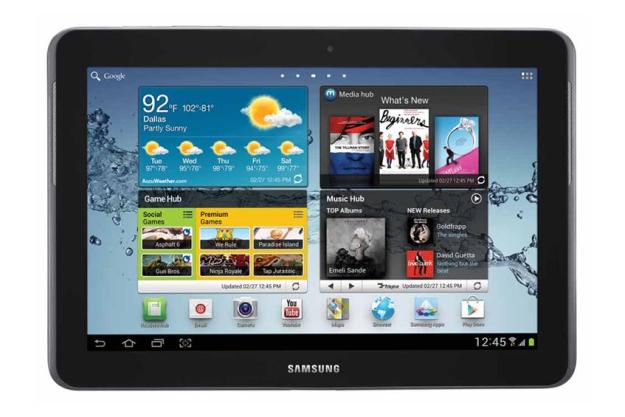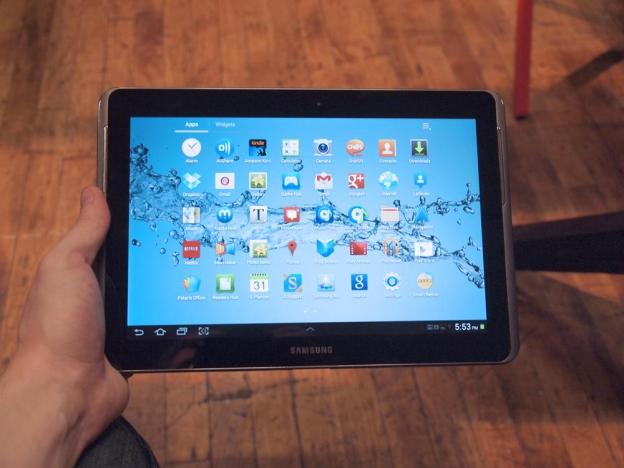
“The Samsung Galaxy Tab 2 10.1 is not a bad tablet, but it's also almost identical, and in some ways inferior, to last year's Galaxy Tab 10.1.”
- Runs Android 4.0
- Front-facing speakers
- Solid construction
- microSD card slot
- $400 price is a bit high
- Poor front and back cameras
- Larger than last year's Galaxy Tab 10.1
In the last year, Samsung has released more tablets than you can shake a stick at. So many, in fact, that it has run out of sensible ways to name them all, leaving us with the new “Samsung Galaxy Tab 2 10.1.” No it’s not the second Galaxy Tab, and it won’t even be the only 10.1-inch Android tablet from Samsung this year. Pretty soon we’ll have the Galaxy Note 10.1 to contend with as well. Strange name aside though, is the Galaxy Tab 2 10.1 worth your time? Find out below.
Video Overview
Look and feel
Samsung doesn’t make a habit on delivering horribly uncomfortable and ugly products (though it definitely does from time to time), and the Galaxy Tab 2 10.1 is another solid improvement in the design and feel of the Korean manufacturer’s larger tablets. Compared to the original Galaxy Tab 10.1, it’s about 1 mm thicker and weighs an extra ounce, but it definitely looks and feels like a better, more unique tablet. It’s still encased in plastic, but now has a darker slate coloring to its shell.
More importantly, this is one of the first tablets that has placed its speakers on the front so they, you know, face at you when you’re watching something. The difference in sound volume is quite profound, giving the Tab 2 at least one small leg up on Apple’s iPad. The speakers complement the new style and add a small border on the left and right sides of the screen (when held in landscape orientation). We’d normally complain about added bezel, but Samsung has also reduced the size of the black glass surrounding the screen.

Though it’s not unique to Samsung, our one problem with the Galaxy Tab 2 10.1 is that 10 inches is just not a great size for widescreen Android tablets. Apple found a great size in 9.7 inches, but the secret to its comfort is its 3:4 aspect ratio, similar to that of an old, non-HD TV. Android tablets have a widescreen, which makes it a bit too tall when you’re using it in portrait mode and a bit too wide when you’re holding it in landscape. We’ve preferred Samsung’s Galaxy Tab 7.7 and Galaxy Tab 8.9 better than its 10-inch models, including this one.
Screen
If you haven’t seen the third iPad’s “Resolutionary” display, you’d be best not to try it unless you’re going to buy. Attempting to go back to a 1280 x 800 pixel resolution after spending so much time with Apple’s 2048 x 1536 pixel Retina display is a definite challenge. There’s nothing technically wrong with it – it’s serviceable – but it is a definitive step down from the newer full HD tablets entering the market. Like most components of the new Tab 2 10.1, the screen is last year’s model, putting it in more direct competition with the iPad 2.
We’ve noticed that the Tab 2 doesn’t appear to have quite as good a screen (colorwise) as its predecessor. This was likely done to save money. The difference isn’t huge, but it appears to be there. Sadly, we don’t have the original device to compare side-by-side to this one.
Operating system
Samsung has made the leap to Android 4.0. The Galaxy Tab 2 10.1 runs Google’s most up-to-date operating system, and, as usual, it’s been modified with TouchWiz, to make it look and operate more consistently with other Samsung devices.

Everything looks mostly the same, but Samsung has upped the size of app icons on the homepage and the notification tray and simplified the overall design to look much closer to Google’s standard Android 4.0. Because it’s the new version of Android, however, buyers will be a bit future-proof since most new apps are being written to take advantage of the new features in the OS. For the first time, Android 4.0 is an OS that runs on both tablets and smartphones, like the Galaxy Nexus.
Preinstalled apps
As usual, Samsung has loaded its tablet with a bunch of useful and useless apps. One cool feature: This tablet comes with one year of free 50GB Dropbox support. Not bad. This should help you sync files between PC and tablet. The Peel Universal TV Remote is also quite cool, and we learned how to control our TV instantly. Unfortunately, it won’t control an Xbox or other devices, so if you don’t have cable, you’re a bit out of luck.
Other apps that come pre-installed include Amazon Kindle, AllShare, ChatON (we couldn’t get this working), Netflix, Next Issue (digital magazines), Zinio, Polaris Office, and a bunch of Samsung Gaming and Media “Hubs,” which try to sell you content.
Keyboard
We don’t usually make a big deal about keyboards, but Samsung’s new default keyboard has a number row on it for the first time, ending the annoying way you’d have to flip to an alternate keyboard screen just to type some numbers. This is great. Not so great, however, is the added handwriting recognition. No matter how hard we tried to accurately write out letters, Samsung’s software never picked them up correctly. To this day, we have not been able to get it to recognize the letter “g”. Not once. But the regular keyboard: thumbs up.
Specs
This tablet is running almost identical specs to the first Tab 10.1. The Galaxy Tab 2 10.1 runs on a 1GHz dual-core processor, 1GB of RAM, 16GB internal storage (11.5GB accessible), a 3-megapixel rear camera with LED flash, and a 0.3-megapixel (VGA) front camera. There is also a microSD slot, a proprietary Samsung charging port (no USB or HDMI), an audio jack, two nice front-facing speakers, and an infrared sensor. Common features like Bluetooth 3.0, accelerometer, gyroscope, and GPS are also included. This also a Wi-Fi tablet, so Wi-Fi b/g/n are the main ways it connects to the Web.
In the Quadrant benchmark test, we achieved a 2,300 to 2,400 average score, which is a bit lower than the Galaxy Tab 8.9 (2,450), Galaxy Tab 7.7 LTE (2,500 to 3,400), or the nearly 5,000 we’ve seen on the HTC One X and S. Still, the Tab 2 10.1 is ahead of its official predecessor. The original Galaxy Tab 10.1 only got about a 1,900 in our tests.
Camera
Only Apple seems willing to invest in tablet cameras. The third-generation iPad has a fantastic rear camera, but even it has a terrible front-facing camera. With the Galaxy Tab 2 10.1, Samsung seems to have decided that cameras need only exist on its tablets; they don’t need to take good pictures. The rear camera is as bad as ever, lacking an adjustable autofocus and taking drab pictures in any circumstance. The front camera has been severely downgraded from last year as well. Instead of a 2-megapixel front camera, the Tab 2 now has a VGA (0.3 megapixel) camera. Not cool for any of you who enjoy video chatting.

Still, as much as we hate to admit it, taking pictures isn’t something we do much of on our tablets – the iPad included. If you’re looking for a decent camera experience, aim for the new iPad, but it’s slim pickings for camera fans across the board.
(Warning: The Tab 2 is incapable of playing 1080p videos. If your collection of full HD content is vast, consider another tablet.)
Battery life
We don’t do traditional battery rundown tests, but we did perform one this time. We charged the Galaxy Tab 2 10.1 and its 7,000mAh battery to full (all night) and let it sit on with the screen set to not timeout. Under these conditions (along with some fairly minor use), the battery lasted between 8 and 9 hours before it died. This isn’t record setting, nor is it particularly bad. It’s about on par with what you might expect.
Overall
The Samsung Galaxy Tab 2 10.1 is not a bad tablet, but it’s also almost identical, and in some ways inferior, to last year’s Galaxy Tab 10.1. At $400 it’s not overly expensive, but it’s also not a deal. You can likely find the original Galaxy Tab 10.1 for less money by now. Also, for $400, you can still afford an iPad 2 and a number of other good, if not superior tablets. We were really hoping for a price between $250 and $300, but Samsung seems determined to keep its prices high. And, as always, we don’t prefer the 10-inch form factor for Android tablets. Apple has made it work, but for Android, smaller sized tablets like the Galaxy Tab 8.9, Motorola Xyboard 8.2, or Galaxy Tab 7.7 are preferable because they’re easier to hold, more portable, but retain the basic functionality of a tablet.
Highs
- Runs Android 4.0
- Front-facing speakers
- Solid construction
- microSD card slot
Lows
- $400 price is a bit high
- Poor front and back cameras
- Larger than last year’s Galaxy Tab 10.1








